
Magnonics is a promising next-generation approach in which quantized spin waves, or magnons, are used to carry information. Magnons are generally hard to manipulate, but a study by Felix Godejohann of the Technical University of Dortmund, Germany, and colleagues could lead to new ways to control magnons via their coupling to acoustic vibrations, or phonons, in a material. The researchers engineered a grooved magnetic structure that allowed them to study and optimize various factors affecting magnon-phonon coupling, achieving an unprecedented coupling strength.
The use of magnons as information carriers entails several prospective benefits. Their high frequencies (GHz to THz) and short wavelengths could lead to faster and smaller memory elements, compared with electron-based circuits. What’s more, magnonics could be free from some of the inherent drawbacks of electronics because it doesn’t require propagating electron currents that are inevitably associated with heating and energy loss.
Even more intriguing are the prospects of using magnons in hybrid quantum information schemes, in which coherent quantum states are shuttled between different systems—superconducting qubits, atoms, ions, and electron spins. This coherent transduction requires ways to efficiently couple various elementary excitations to one another. Magnons can conveniently couple to microwave photons, which can interact, for instance, with atoms and ions. Phonons could perform a similar role, as they could mediate the transduction from magnons to electrons.
Godejohann and colleagues have brought the coupling strength to new heights and have shed light on the factors that contribute to it. The team devised a clever scheme by which they could tweak the various factors contributing to magnon-phonon hybridization. They used a thin film of Galfenol—a highly magnetostrictive alloy of iron and gallium—and carved 7-nm-thick parallel grooves onto the film’s surface, producing a grating-like pattern with a 200-nm period. Such a grating affects the spatial distribution of both magnons and phonons, whose overlap influences the strength of their mutual coupling.
The paper has been published in APS Physics – Physical Review B.
